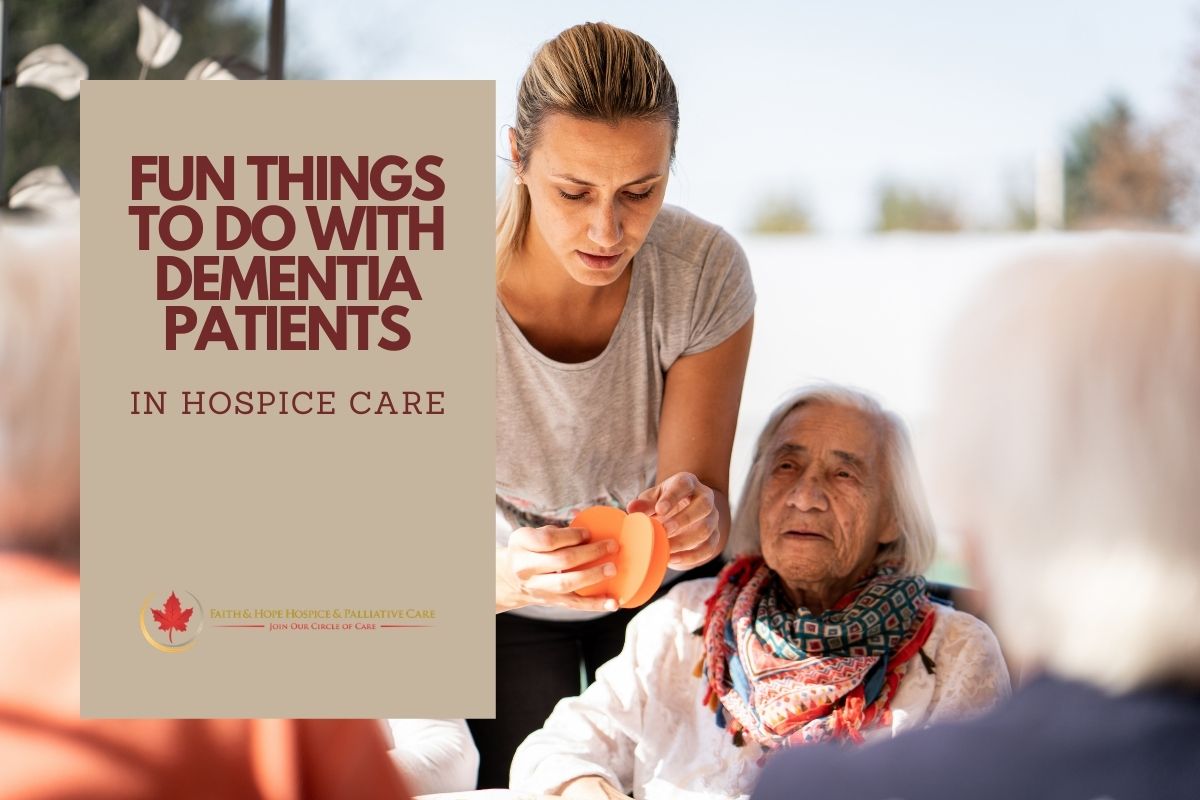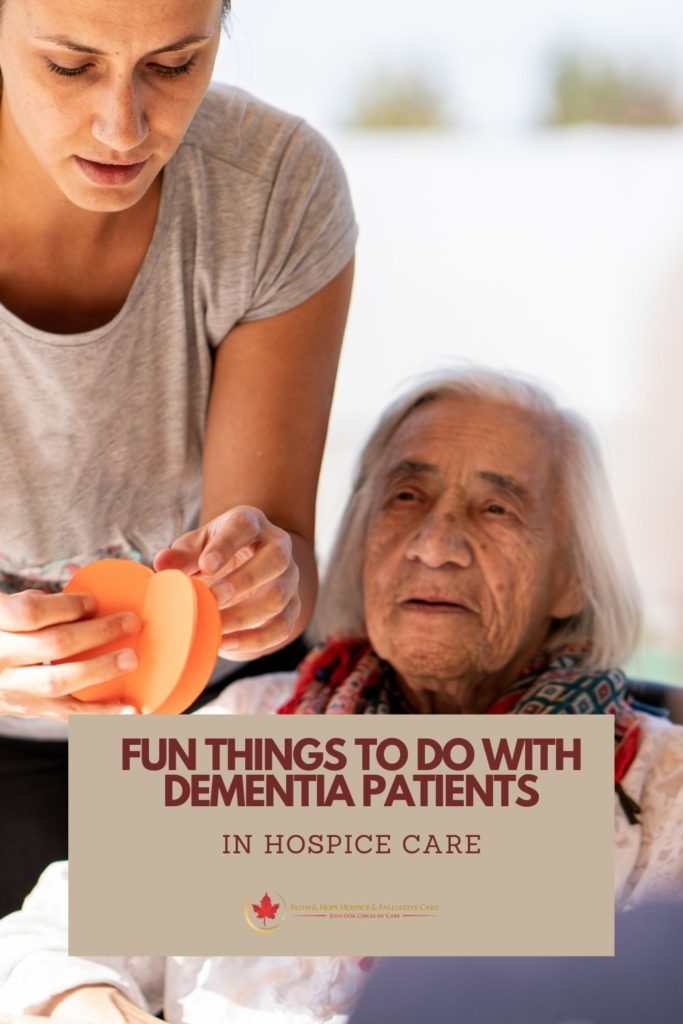
- By: administrator
- Blog
- No Comments
Although dementia patients face cognitive decline, they can still gain a great amount of satisfaction from hospice care in Burbank CA. Dementia can affect the left temporal lobe of the brain, which is responsible for language processes and comprehension. This is why many dementia patients start to lose their ability to communicate verbally. However, many dementia patients retain the ability to recall the words to their favorite song, poem, or scripture. It is not uncommon for otherwise non-verbal patients to suddenly be able to recite a poem or sing a song that is linked to happy times in their life.

In order to care for dementia patients properly, hospice experts in Burbank CA particularly Faith and Hope Hospice and Palliative Care rely on creative modes of expression like music-making, art-making, and other tactile projects. There are many different kinds of activities that you can try with dementia patients in order to stimulate them in a positive way.
As always, make sure that you are catering to the patient’s individual needs. You may want to engage the patient in light conversation, play soothing music in the background, and patiently help them with the activity. The key is to go at their pace and let them decide when they are done doing the arts and crafts project. Remember that each craft doesn’t need to be done a certain way. If you start out with one thing and end up with another, then so much the better! Patients enjoy having a sense of control and if they like their creation better than the original plan, then they are still getting a good experience out of the activity (and that’s all that matters). So, when you’re planning your arts and crafts, make sure to leave a little room for improvisation. Here are a few tactile activities to try with dementia patients:
Craft #1: Cute Ice Cream Cone Planter
Arts and crafts are a great activity for patients of all ages. They can distract them from anxious and fearful thoughts as well as allow the space for calm, creative expression, and relaxation. Doing arts and crafts with a dementia patient can help keep their minds engaged in a positive way and also allow them to bond with other patients, family members, or caregivers.
This ice cream cone planter project is a cute and fun activity that you can try with dementia patients in order to improve their coordination and motor skills. Patients with dementia often feel a sense of satisfaction after completing a project like this. It shows them that they can do things for themself and gives them a sense of control. Plus, they can keep their arts and crafts items around to remind them of happy times. Here’s how to make the ice cream cone planter craft:
Materials:
- A small succulent
- Mini terra cotta planter
- Colorful markers
- Colorful acrylic paint
- Paintbrushes
Directions:
- Use a brown-colored marker to draw x’s on the base of the planter (the ice cream cone).
- Paint the rim of the planter like dripping ice cream. It doesn’t have to be perfect!
- Once the paint dries, add colorful dashes with the markers to represent sprinkles.
- Transfer the succulent onto the new planter. Enjoy!
Craft #2: Fun Tactile Stimulation Pillow
Dementia patients receiving hospice care can greatly benefit from sensory stimulation. Studies have shown that tactile stimulation can act as a sort of therapy for dementia patients in order to improve feelings of relaxation and trust. Products like fidget blankets are made with this concept in mind. Different zippers, buttons, and fabric textures promote healthy movement and motor coordination.
Other methods of tactile stimulation and therapy include activity boxes, which contain interesting items like pine cones, sandpaper, flowers, and other textured objects. Patients with dementia enjoy the process of opening these boxes and taking out items one by one to investigate them. If you decide to make one of these activity boxes, make sure to avoid putting anything that could potentially harm the patient including sharp objects or small objects that could accidentally be swallowed.
If you want to create something a little plusher, then consider a tactile stimulation pillow! These look good as an accessory and they double as sensory therapy for a dementia patient. Here’s how you can make it:
Materials:
- Pre-made pillowcase
- Pillow insert
- Different fabrics (fun textures)
- Safety scissors
- Double-sided fabric tape
Directions:
- Cut up your fabric samples into a variety of shapes.
- Use the double-sided fabric tape to attach the fabric shapes to the pillow cover in a fun pattern.
- Insert the pillow and you’re good to go!
Craft #3: Pretty Pine Cone Flowers
The best thing about arts and crafts is having the freedom to imagine. Dementia patients benefit from activating their imagination and creating things that are beautiful to look at. This pine cone flower craft lets you use a sensory object to create a fun craft. Pine cones can be collected in nature or purchased at your local craft store. You can get scented or unscented ones, depending on what you think will be enjoyed the most. Then, you can utilize their interesting design for a floral masterpiece! Keep them in a bowl or on a shelf to have a beautiful, long-lasting bouquet. Many dementia patients like the way that pine cones feel and will enjoy having this pretty craft around to look at, smell, and touch. Here’s how to make pretty pine cone flowers:
Materials:
- Pinecones
- Display bowl or basket
- Acrylic paint (bright colors and white)
- Paintbrushes
Directions:
- Take a pine cone and turn it upside down, this will serve as the flower.
- Paint a white base coat on the pine cone and let dry.
- Use your bright acrylic paint to paint over the white, representing the petals of the flower.
- Let paint fully dry and display in a basket or bowl. Enjoy!
Our team at Faith & Hope Hospice & Palliative Care is prepared to offer meaningful care for patients with all levels of dementia through holistic practices like art therapy and music therapy. If you or a loved one is in need of end-of-life care, please contact Faith & Hope at (877) 797-1977. You can also visit our website to learn more about our range of services and collect some useful resources about hospice care: https://faithandhopehospice.com/.
